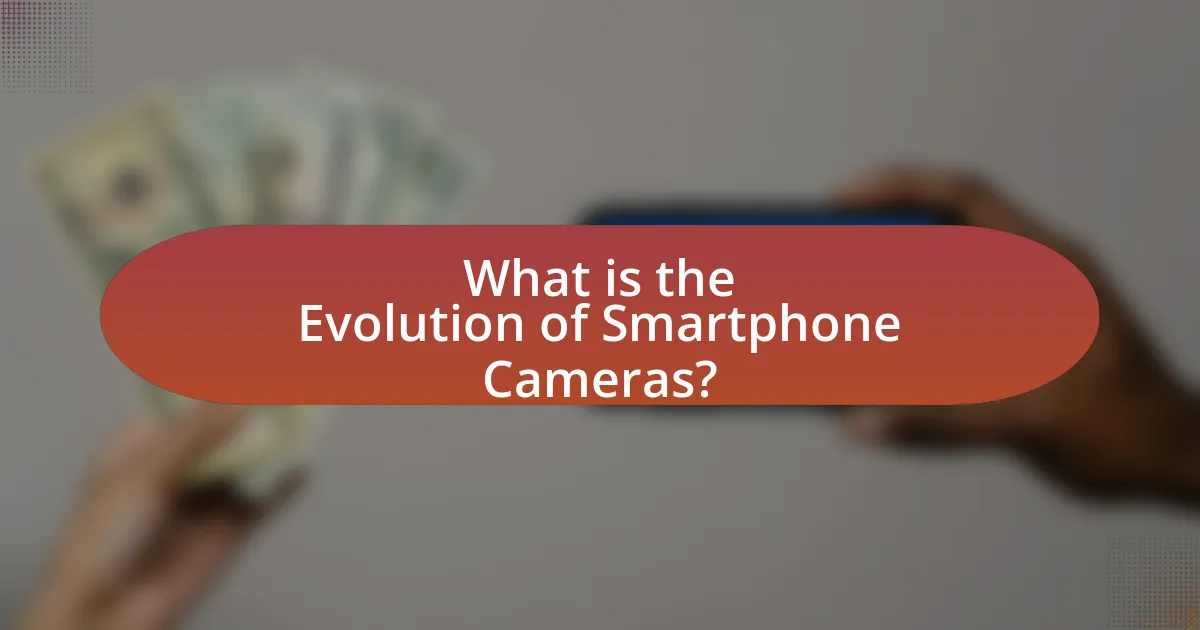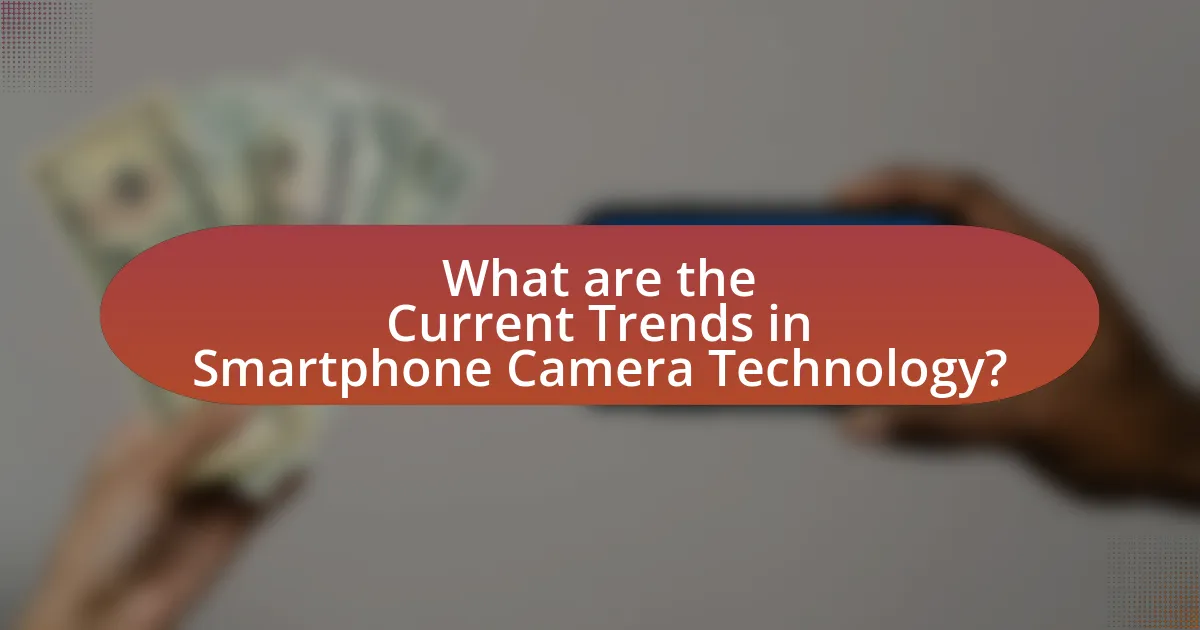The article examines the evolution of smartphone cameras, tracing their development from basic VGA sensors to advanced multi-lens systems that rival professional cameras. Key milestones include the introduction of higher megapixel counts, dual-camera systems, and computational photography techniques, which have significantly enhanced image quality and user experience. The discussion highlights current trends such as AI integration, low-light performance improvements, and the impact of consumer demand on camera innovations. Additionally, the article explores future predictions for smartphone camera technology, including advancements in sensor capabilities and the influence of augmented reality and 5G connectivity on photography.

What is the Evolution of Smartphone Cameras?
The evolution of smartphone cameras has progressed from basic VGA sensors in early models to advanced multi-lens systems with capabilities rivaling professional cameras. Initially, the first smartphones, like the Nokia 7650 released in 2002, featured a 0.3 MP camera, which was primarily for basic photo capture. As technology advanced, the introduction of 5 MP cameras in devices like the iPhone 4 in 2010 marked a significant improvement in image quality.
By 2016, smartphones began incorporating dual-camera systems, such as the iPhone 7 Plus, allowing for enhanced depth perception and improved low-light performance. The trend continued with the introduction of features like optical zoom, image stabilization, and AI enhancements, culminating in devices like the Samsung Galaxy S21 Ultra, which boasts a 108 MP camera and multiple lenses for versatile photography.
This trajectory reflects a broader trend in consumer demand for high-quality photography in mobile devices, leading to innovations such as computational photography, which uses software algorithms to enhance images. The smartphone camera has thus evolved into a critical feature, influencing purchasing decisions and shaping the mobile technology landscape.
How have smartphone cameras changed over the years?
Smartphone cameras have significantly improved over the years in terms of resolution, features, and technology. Initially, smartphones featured basic cameras with low megapixel counts, such as the 0.3 MP camera on the first iPhone in 2007. As technology advanced, manufacturers began incorporating higher megapixel sensors, with many modern smartphones now offering 108 MP cameras, enabling detailed and high-quality images.
Additionally, advancements in optics, image processing algorithms, and low-light performance have enhanced photo quality. For instance, the introduction of multiple camera systems, such as wide-angle and telephoto lenses, has expanded creative possibilities for users. Furthermore, features like optical image stabilization and AI-driven enhancements have improved the overall photography experience.
The shift from simple point-and-shoot capabilities to sophisticated imaging systems reflects a broader trend in consumer demand for high-quality photography in mobile devices, making smartphone cameras a primary tool for capturing everyday moments.
What were the first smartphone cameras like?
The first smartphone cameras were rudimentary, typically featuring low resolution and basic functionality. For instance, the first commercially available smartphone with a camera, the Nokia 7650, released in 2002, had a 0.3-megapixel camera that could capture images at a resolution of 640×480 pixels. These early cameras often lacked advanced features such as autofocus, flash, or image stabilization, resulting in images that were grainy and of poor quality compared to modern standards. The limited technology of the time restricted the capabilities of these cameras, making them primarily useful for casual snapshots rather than high-quality photography.
How did technological advancements influence smartphone camera development?
Technological advancements significantly influenced smartphone camera development by enabling higher resolution sensors, improved image processing algorithms, and enhanced optical capabilities. For instance, the introduction of multi-lens systems, such as wide-angle and telephoto lenses, has allowed smartphones to capture a broader range of images, enhancing versatility. Additionally, advancements in computational photography, including techniques like HDR (High Dynamic Range) and AI-driven enhancements, have improved image quality in various lighting conditions. The transition from 8-megapixel sensors in early smartphones to 108-megapixel sensors in recent models exemplifies this evolution, showcasing the impact of sensor technology on image clarity and detail.
What are the key milestones in smartphone camera evolution?
The key milestones in smartphone camera evolution include the introduction of the first camera phone in 2000, which was the Sharp J-SH04, featuring a 0.11-megapixel camera. In 2002, Nokia launched the 7650, which had a 0.3-megapixel camera and became widely popular. The 2007 release of the Apple iPhone marked a significant turning point, as it integrated a 2-megapixel camera with advanced software capabilities. In 2010, the HTC Evo 4G introduced an 8-megapixel camera, further enhancing image quality. The 2012 launch of the Nokia 808 PureView showcased a 41-megapixel sensor, setting a new standard for smartphone photography. By 2016, dual-camera systems emerged with the iPhone 7 Plus, allowing for improved depth of field and low-light performance. The introduction of computational photography techniques in recent years, particularly with devices like the Google Pixel, has revolutionized image processing, enabling high-quality photos even in challenging conditions. Each of these milestones has contributed to the rapid advancement of smartphone camera technology, making them essential tools for photography.
Which smartphone models introduced significant camera innovations?
Smartphone models that introduced significant camera innovations include the Nokia 808 PureView, Apple iPhone 7 Plus, Google Pixel, and Samsung Galaxy S21 Ultra. The Nokia 808 PureView, released in 2012, featured a 41-megapixel sensor that revolutionized mobile photography by allowing for high-resolution images and advanced digital zoom capabilities. The Apple iPhone 7 Plus, launched in 2016, introduced a dual-camera system that enabled portrait mode and optical zoom, enhancing depth-of-field effects. The Google Pixel, first released in 2016, utilized advanced computational photography techniques, including HDR+ and Night Sight, to improve low-light performance and image quality. The Samsung Galaxy S21 Ultra, released in 2021, showcased a 108-megapixel sensor and multiple telephoto lenses, pushing the boundaries of zoom capabilities and image detail. These models exemplify key advancements in smartphone camera technology, influencing subsequent designs and features in the industry.
How did consumer demand shape the evolution of smartphone cameras?
Consumer demand significantly influenced the evolution of smartphone cameras by driving manufacturers to prioritize higher quality imaging features. As users increasingly sought better photography capabilities for social media sharing and personal documentation, companies responded by integrating advanced technologies such as multi-lens systems, improved sensors, and enhanced software algorithms. For instance, the introduction of dual-camera setups by Apple in the iPhone 7 Plus in 2016 was a direct response to consumer preferences for portrait modes and improved low-light performance. This trend continued with the rise of features like optical zoom and AI enhancements, reflecting a clear alignment with user expectations for professional-grade photography in compact devices.
What role do smartphone cameras play in modern photography?
Smartphone cameras are integral to modern photography, serving as the primary tool for capturing images for a vast majority of people. They democratize photography by providing high-quality imaging capabilities in a compact and accessible format, allowing users to take professional-grade photos without the need for expensive equipment. According to a report by the International Data Corporation, over 1.4 billion smartphones were shipped globally in 2020, with camera quality being a key selling point, highlighting their significance in everyday photography. Additionally, advancements in smartphone camera technology, such as multi-lens systems and AI enhancements, have further elevated their role, enabling users to experiment with various photography styles and techniques that were once limited to traditional cameras.
How have smartphone cameras impacted professional photography?
Smartphone cameras have significantly democratized professional photography by making high-quality imaging accessible to a broader audience. The introduction of advanced features such as multi-lens systems, computational photography, and AI enhancements in smartphones has allowed amateur photographers to produce images that rival those taken with traditional professional cameras. For instance, a study by the International Journal of Computer Applications found that smartphone cameras have improved image quality to the point where 92% of photographers reported using smartphones for professional work at least occasionally. This shift has led to a more competitive landscape, where professional photographers must adapt to the changing technology and incorporate smartphone capabilities into their workflows.
What are the social implications of smartphone photography?
Smartphone photography has significant social implications, including the democratization of image creation and the impact on social interactions. The widespread availability of smartphones equipped with high-quality cameras allows individuals from diverse backgrounds to capture and share their experiences, leading to a more inclusive representation of society. This shift has transformed social media platforms into visual storytelling spaces, where personal narratives can reach global audiences, fostering community and connection. Additionally, studies indicate that the prevalence of smartphone photography influences social behavior, as individuals often curate their lives for online consumption, which can affect self-esteem and interpersonal relationships. For instance, research published in the journal “Computers in Human Behavior” highlights that social media users frequently compare themselves to others based on visual content, impacting mental health and social dynamics.

What are the Current Trends in Smartphone Camera Technology?
Current trends in smartphone camera technology include the integration of multiple lenses, advancements in computational photography, and the use of artificial intelligence for image processing. Smartphone manufacturers are increasingly adopting multi-camera systems, allowing for enhanced versatility in photography, such as ultra-wide, telephoto, and macro capabilities. For instance, devices like the iPhone 14 Pro and Samsung Galaxy S23 Ultra feature sophisticated camera setups that improve image quality and provide users with a range of shooting options.
Additionally, computational photography techniques, such as HDR (High Dynamic Range) and Night Mode, are becoming standard, enabling smartphones to capture high-quality images in challenging lighting conditions. AI algorithms are also being utilized to optimize image processing, enhance facial recognition, and apply real-time filters, significantly improving user experience and image output. According to a report by Counterpoint Research, the global smartphone camera market is expected to grow at a CAGR of 10% from 2021 to 2026, highlighting the increasing importance of camera technology in consumer preferences.
What features are currently popular in smartphone cameras?
Currently, popular features in smartphone cameras include multiple lenses, high megapixel counts, advanced image stabilization, and AI-enhanced photography. Multiple lenses allow for versatility in capturing wide-angle, macro, and portrait shots, catering to diverse photography needs. High megapixel counts, often exceeding 100 megapixels in flagship models, enable detailed images suitable for large prints and cropping without loss of quality. Advanced image stabilization, such as optical image stabilization (OIS) and electronic image stabilization (EIS), significantly reduces blurriness in photos and videos, enhancing overall image clarity. AI-enhanced photography features, including scene recognition and automatic adjustments, optimize settings for various conditions, making it easier for users to achieve professional-quality results. These features reflect the ongoing trend towards improving user experience and image quality in smartphone photography.
How do multiple lenses enhance smartphone photography?
Multiple lenses enhance smartphone photography by providing diverse focal lengths and improved image quality. This allows users to capture a wider range of scenes, from expansive landscapes with ultra-wide lenses to detailed close-ups with macro lenses. Additionally, multiple lenses enable features such as optical zoom, which maintains image clarity at various distances, unlike digital zoom that can degrade quality. For instance, smartphones with dual or triple camera systems can combine data from different lenses to create images with better depth perception and enhanced low-light performance, as seen in models like the iPhone 13 Pro and Samsung Galaxy S21 Ultra. This technological advancement reflects a significant trend in smartphone camera evolution, catering to the growing demand for professional-quality photography in compact devices.
What is the significance of AI in smartphone camera functionality?
AI significantly enhances smartphone camera functionality by enabling advanced features such as scene recognition, image stabilization, and computational photography. These capabilities allow smartphones to automatically adjust settings for optimal image quality based on the environment, improving low-light performance and enhancing details in photos. For instance, AI algorithms can analyze a scene to identify subjects and apply effects like background blur or HDR, resulting in professional-quality images. Research indicates that AI-driven enhancements can increase user satisfaction and engagement, as evidenced by a 2021 study from the International Journal of Computer Vision, which found that AI integration in mobile photography led to a 30% improvement in user-perceived image quality.
How are smartphone cameras adapting to user needs?
Smartphone cameras are adapting to user needs by incorporating advanced features such as improved low-light performance, AI-driven enhancements, and versatile multi-lens systems. These adaptations address the demand for high-quality photography in various conditions, enabling users to capture professional-grade images without extensive photography knowledge. For instance, the introduction of night mode in devices like the iPhone 11 and Google Pixel 4 allows users to take clear photos in dim lighting, showcasing the technology’s responsiveness to user preferences for usability and quality. Additionally, AI algorithms in smartphones analyze scenes and optimize settings automatically, catering to users who seek convenience and efficiency in their photography experience.
What trends are emerging in low-light photography capabilities?
Emerging trends in low-light photography capabilities include the integration of larger image sensors, advanced computational photography techniques, and improved lens designs. Larger sensors, such as those found in flagship smartphones, capture more light, enhancing image quality in dim conditions. Computational photography, utilizing algorithms to enhance images, allows for noise reduction and detail preservation, even in challenging lighting. Additionally, innovations like multi-frame processing and night mode features enable smartphones to combine multiple exposures for clearer, brighter images. These advancements are supported by industry data showing that smartphones with enhanced low-light capabilities are increasingly favored by consumers, reflecting a growing demand for high-quality photography in various lighting environments.
How is video recording evolving in smartphone cameras?
Video recording in smartphone cameras is evolving through advancements in resolution, stabilization, and features like AI enhancements. Recent models now support 8K video recording, significantly improving clarity and detail compared to earlier 1080p and 4K standards. Additionally, optical and electronic image stabilization technologies have become more sophisticated, reducing shake and enhancing video quality during movement. AI-driven features, such as scene recognition and automatic adjustments, further optimize video capture, making it easier for users to achieve professional-quality results. These developments reflect a broader trend towards integrating high-end camera capabilities into smartphones, catering to the increasing demand for high-quality mobile content creation.
What are the challenges facing smartphone camera manufacturers today?
Smartphone camera manufacturers face several challenges today, including intense competition, technological limitations, and consumer expectations. The market is saturated with numerous brands, making differentiation difficult; for instance, companies like Apple, Samsung, and Google continuously innovate to capture market share. Additionally, manufacturers struggle with the physical constraints of smartphone design, which limit sensor size and optical capabilities, impacting image quality. Consumer expectations have also risen, with users demanding higher resolution, better low-light performance, and advanced features like computational photography. According to a report by Counterpoint Research, the demand for high-quality camera systems has led to a 20% increase in smartphone camera module prices, highlighting the financial pressures manufacturers face in meeting these expectations.
How do privacy concerns affect smartphone camera usage?
Privacy concerns significantly reduce smartphone camera usage, as users become increasingly aware of potential surveillance and data breaches. Research indicates that 81% of Americans feel they have little to no control over their personal information, leading to hesitance in using cameras for sensitive situations. This awareness results in users disabling camera features or avoiding photography in private settings, reflecting a broader trend where privacy considerations dictate technology engagement.
What are the limitations of current smartphone camera technology?
Current smartphone camera technology is limited by factors such as sensor size, low-light performance, and optical zoom capabilities. The small sensor size in smartphones restricts the amount of light captured, resulting in poorer image quality in low-light conditions compared to larger sensors found in dedicated cameras. Additionally, most smartphones rely on digital zoom rather than optical zoom, which degrades image quality when zooming in on subjects. Furthermore, the computational photography techniques used to enhance images can sometimes lead to unnatural results, as they may not accurately represent the scene. These limitations highlight the challenges smartphone cameras face in achieving the same level of performance as traditional cameras.

What Predictions Can Be Made for the Future of Smartphone Cameras?
Future smartphone cameras are predicted to feature advanced computational photography, improved low-light performance, and enhanced AI capabilities. These advancements will likely stem from ongoing developments in image processing algorithms and sensor technology, enabling smartphones to capture images with greater detail and dynamic range. For instance, the integration of larger sensors and multi-lens systems is expected to become standard, allowing for better depth perception and versatility in photography. Additionally, the use of AI for real-time image enhancement and scene recognition will further refine the quality of photos taken in various conditions. According to a report by Counterpoint Research, the global smartphone camera market is projected to grow significantly, indicating a strong trend towards innovation in this area.
How might smartphone camera technology evolve in the next decade?
Smartphone camera technology is likely to evolve significantly in the next decade through advancements in sensor technology, computational photography, and integration of artificial intelligence. Enhanced sensors will enable higher resolution images and improved low-light performance, as seen with the transition from 12MP to 108MP sensors in recent flagship models. Computational photography will further refine image quality by utilizing algorithms to enhance details and reduce noise, a trend already evident in devices like the Google Pixel series. Additionally, AI will play a crucial role in real-time image processing, enabling features such as scene recognition and automatic adjustments, which are becoming standard in current smartphones. These trends indicate a trajectory towards more sophisticated, user-friendly photography experiences, making high-quality imaging accessible to a broader audience.
What advancements in sensor technology are expected?
Advancements in sensor technology are expected to include increased resolution, improved low-light performance, and enhanced computational photography capabilities. These improvements will enable smartphone cameras to capture more detailed images, perform better in challenging lighting conditions, and utilize advanced algorithms for image processing. For instance, the transition to larger sensor sizes and the integration of multi-lens systems are already being implemented, allowing for greater depth of field and improved image quality. Additionally, innovations such as stacked sensor designs and back-illuminated sensors are set to enhance light sensitivity and dynamic range, further elevating the overall photographic experience in smartphones.
How could augmented reality influence smartphone photography?
Augmented reality (AR) could significantly enhance smartphone photography by integrating digital elements into real-world images, allowing users to create more engaging and interactive photos. This technology enables features such as real-time filters, 3D overlays, and contextual information that can transform a simple photograph into a dynamic visual experience. For instance, AR applications like Snapchat and Instagram utilize facial recognition and augmented filters to enhance selfies, demonstrating a practical application of AR in smartphone photography. Additionally, studies show that AR can improve user engagement and creativity, as users are more likely to experiment with their photography when provided with interactive tools.
What emerging technologies could shape the future of smartphone cameras?
Emerging technologies that could shape the future of smartphone cameras include computational photography, artificial intelligence, and advanced sensor technology. Computational photography enhances image quality through software algorithms, allowing for features like HDR and portrait modes, which have become standard in modern smartphones. Artificial intelligence improves image processing by enabling features such as scene recognition and automatic adjustments, making photography more accessible to users. Advanced sensor technology, including larger sensors and improved low-light performance, allows smartphones to capture higher-quality images in various conditions. These technologies collectively drive innovation in smartphone cameras, as evidenced by the rapid advancements seen in flagship models from brands like Apple and Samsung, which consistently integrate these features to enhance user experience.
How might computational photography change the way we take pictures?
Computational photography will significantly change the way we take pictures by enhancing image quality and enabling new creative possibilities. This technology utilizes algorithms to process images, allowing for features such as improved low-light performance, background blur effects, and high dynamic range imaging. For instance, smartphones like the Google Pixel employ computational photography techniques to produce clearer images in challenging lighting conditions, demonstrating a marked improvement over traditional photography methods. As a result, users can capture professional-quality photos without needing advanced photography skills or equipment.
What role will 5G play in the future of smartphone camera capabilities?
5G will significantly enhance smartphone camera capabilities by enabling faster data transmission and improved connectivity. This increased speed allows for real-time processing of high-resolution images and videos, facilitating features such as 8K video streaming and instant sharing without lag. Additionally, 5G’s low latency supports advanced applications like augmented reality (AR) and artificial intelligence (AI) in photography, allowing for features such as real-time image enhancement and object recognition. The combination of these capabilities will lead to a more immersive and interactive photography experience, as evidenced by the growing integration of AI and AR in smartphones, which is expected to expand with the rollout of 5G networks.
What practical tips can users follow to maximize their smartphone camera experience?
To maximize their smartphone camera experience, users should focus on understanding and utilizing the camera settings effectively. Adjusting settings such as ISO, shutter speed, and white balance allows for better control over image quality in various lighting conditions. For instance, using a lower ISO in bright conditions reduces noise, while a higher ISO can enhance performance in low light. Additionally, users should explore features like HDR (High Dynamic Range) to capture more detail in high-contrast scenes, and utilize grid lines to apply the rule of thirds for better composition. Regularly cleaning the camera lens ensures clarity in photos, as smudges can significantly degrade image quality. These practices are supported by photography experts who emphasize the importance of technical knowledge and composition in achieving professional-looking results.




